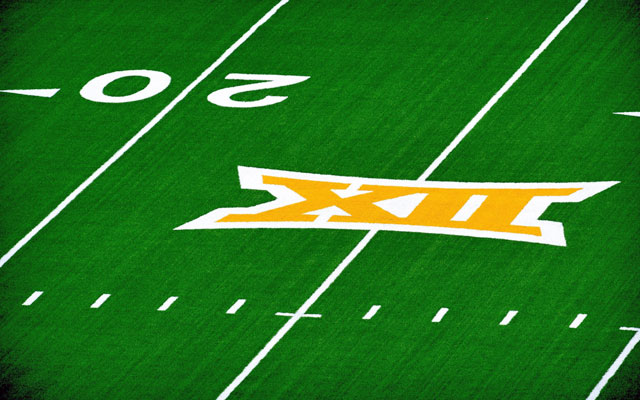What’s going on in the Big 12 qualifies as the biggest potential upheaval in conference realignment … since the last round of conference realignment in 2010-11.
There is talk of expansion, adding a Big 12 network and scheduling a league championship game. The problem is you’re only getting one slanted, biased voice on these topics: Oklahoma president David Boren.
The outspoken 74-year-old wants all three of those things. In that sense, he has caused more consternation than actual action. It’s fair to say there is more frustration with Boren within the league than progress toward any of his proposals.
With that in mind, here’s what you don’t know about what the Big 12 will look like in the future. Some of these points emerged from interviews with sources inside and outside Power Five leagues who are familiar with the situation …
What we know: Boren and West Virginia president Gordon Gee are on record advocating the 10-team Big 12 expand to 12 teams -- at least. Gee’s motivation is clear. His school needs an Eastern travel partner. West Virginia’s closest Big 12 rival is Iowa State, almost 1,000 miles away. Boren believes the league is at a “psychological disadvantage” going forward with only 10 teams.
Boren further believes the Big 12 would be shored up with more members. That would require rights holders ESPN and Fox to pony up more money. The same for a network and a conference championship game. As colleague Jon Solomon reported, the Big 12 is currently third in conference revenue, more than $9 million behind No. 1 SEC.
Whether the Big 12 will ever be higher than No. 3 in the pecking order is up for debate. Its place in the revenue universe is a function of the market. The SEC and Big Ten remain bigger, broader and more attractive to viewers, advertisers and (perhaps) recruits than 20 years ago. No one noticed 20 years ago when the Big 12 was No. 3. Now there’s more money in the system. Some sort of conclusion on the Big 12’s future may be reached at conference meetings in late May and early June.
What we don’t know: It’s complicated. More teams means insurance -- a better chance the Big 12 will continue to exist if others leave. But about the only reason the Big 12 exists in its current form in the first place is the presence of Oklahoma and Texas. A loss of one or both means trouble for the league. One industry source speculated Boren’s long-term play may be to destabilize the conference enough to get Oklahoma out of the grant of rights agreement and move to another league. More on that below.
For now, this all revolves about the league’s nervousness in the College Football Playoff era. It is the only major conference that doesn’t play a league championship game. It’s the only major conference that plays a round-robin schedule. Boren contends the Big 12 is at a “disadvantage” by not playing that 13th game. Based on recent interviews, it’s fair to say the majority of Big 12 athletic directors aren’t in favor of expansion.
Some league leaders freaked out when the Big 12 was left out of the 2014 CFP. Oklahoma got in last season. Decisions are being made on a sample that has all of two components. The Big 12 is batting .500 in the CFP. Is that reason enough to renovate the entire conference?
First, there’s no need. Recent conference championship game deregulation means the Big 12 can stage such a game with 10 teams. Second, there’s the possibility the Big 12 would be diluting itself competitively with any available candidates. (Goodbye, round-robin.) For this discussion going forward, we’ll use Cincinnati and BYU.

Who is going to pay for expansion? As one network executive once told me, the likes of ESPN aren’t necessarily in the business of wanting to pay for all this realignment. There seems to be a feeling that adding Cincinnati and BYU -- or anyone else -- would mean nothing more than a slight bump in the Big 12’s rights fees ($23 million per school). But it wouldn’t be the home run the Big Ten hit with Nebraska.
In that sense, expansion has evolved from being about brand to being about volume. Both Rutgers and Maryland are running deficits. Football is slumping. Yet the mere suggestion the pair could deliver the New York and Washington D.C. markets was enough for commissioner Jim Delany and the Big Ten.
Sorry, but BYU and Cincinnati just do not bring enough brand recognition or volume (TV sets) to the Big 12. Together, they’d have to bring $46 million per year just for the Big 12 to break even. There is no meaningful pro rata. Definition: Additional teams brining the same money to the table.
What expansion does bring is inventory -- more games to be bid on. Those games could be used to populate a conference network. But remember what I said about networks having no desire to pay more? ESPN paid the SEC $2.25 billion for its rights in 2008, “ending any conversation of a conference network.” Then the SEC convinced ESPN to pay more for a conference network in 2013. Does the Big 12 have that kind of juice? The league presidents will have to answer by stepping out on a financial ledge.
Conference championship game uncertainty: It looms large because there’s another ledge the league would have to step out on. During the 15 years the Big 12 did stage a championship game (1996-2010), the Big 12 favorite lost six times (40 percent). That’s the highest failure rate among major conferences. In the combined 120-year history of the old Big Eight and Southwest Conference playing round-robin conference schedules in the wire-service era (1936-95), there were 16 national champions that were either undefeated or one-loss teams. That’s a 13 percent success rate without playing a championship game.
Conclusion: It would an absolute crap shoot to vote in a conference championship game with that conflicting data swirling.
Outside help: The Big 12 has engaged Chicago-based Navigate Research to essentially vet expansion candidates. While Navigate’s website says it offers marketing solutions -- current college clients include Arizona State and Ohio State -- essentially, it can do a deep-dig comparison on, say, Memphis vs. Houston.
The Big 12 has also hired Chris Bevilacqua and his Bevilacqua Helfant Ventures. Bevilacqua is a high-powered and respected consultant who helped both the Big 12 and Pac-12 during realignment. Bevilacqua’s current work with the Big 12 has only recently started, according to a source.
Boren wants what’s best for Boren: The Oklahoma president is not a populist. He is positioning OU for the future. As mentioned earlier, he could find a workaround for that grant of rights which has bound the league together since 2010. No doubt, there would be plenty of interest in OU from the likes of the Big Ten and Pac-12.
A grant of rights means a school surrenders its primary media rights if it leaves the conference. Without saying it, Boren is saying it. OU could easily skip to another conference if it doesn’t get what he wants. Some still blame him for driving Missouri to the SEC in 2011. Boren stated then Oklahoma would not be a “wallflower” in realignment.
As more than one source pointed out, though -- where can Oklahoma go at the moment? It would have to mount legal challenge to what was advertised as an iron-clad agreement. There are likely political considerations if the Sooners are forced to take Oklahoma State with them in any move.
Network difficulties: A conference network almost certainly means the league would further relinquish some scheduling autonomy. That possibly means Sunday night games in basketball, more Thursday games in football, more primetime games on Saturday. A media partner needs to make its money back. “Is that worth the trade off to continually disenfranchise your fan base?” one source asked.
The conference looks bipolar at times. Former commissioner Kevin Weiberg and later Dan Beebe tried to push through a network. The conclusion was there wasn’t enough interest to make it work. Beebe, who was basically run out by Boren in 2011, couldn’t get schools to agree to a grant of rights. Now that agreement binds the league together and a network is a possibility.
“If we’d done it [network] back in the day,” said one person familiar with the talks, “there might be more of a national footprint.”
Might. The Big Ten labored long and hard, figuratively going door-to-door to get cable systems to carry its network. That meant, at first, getting a dime per cable subscriber outside its market and $1 inside its nine-state footprint to establish its network. Even with a network partner, the Big 12 would have to make that same slog for what is called “carriage” on cable systems. That, with a much smaller population base than the Big Ten.
Just like back then, it’s difficult to understand how the Big 12 could make a network succeed. The Pac-12 Network has basically underachieved because of lack of interest and passion in the West. More than one media analyst has suggested the infrastructure is there for a Big 12 network. It’s called the Longhorn Network and its state-of-the-art facilities. Simply operate a Big 12 network out of Austin.
But we’d be talking about a league that once eschewed a network due to lack of interest, then allowed Texas to have a network, then admit the LHN had failed only to use the leftover production facilities to expand to a conference-wide Big 12 network.
As we said, it's complicated.




















